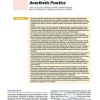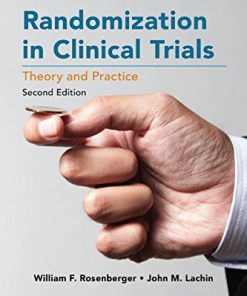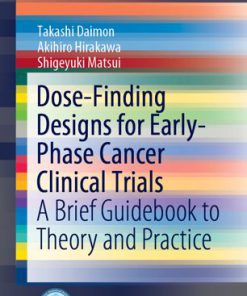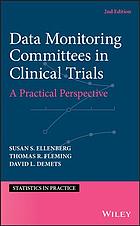Innovative Strategies Statistical Solutions and Simulations for Modern Clinical Trials 1st Edition by Mark Chang, John Balser, Jim Roach, Robin Bliss ISBN 0815379447 9780815379447
$50.00 Original price was: $50.00.$25.00Current price is: $25.00.
Innovative Strategies Statistical Solutions and Simulations for Modern Clinical Trials 1st Edition by Mark Chang, John Balser, Jim Roach, Robin Bliss – Ebook PDF Instant Download/Delivery: , 978-
Full download Innovative Strategies Statistical Solutions and Simulations for Modern Clinical Trials 1st Edition after payment
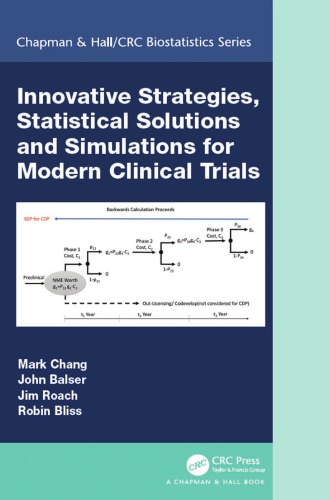
Product details:
ISBN 10:
ISBN 13: 978-
Author: Mark Chang, John Balser, Jim Roach, Robin Bliss
“This is truly an outstanding book. [It] brings together all of the latest research in clinical trials methodology and how it can be applied to drug development…. Chang et al provide applications to industry-supported trials. This will allow statisticians in the industry community to take these methods seriously.” Jay Herson, Johns Hopkins University
The pharmaceutical industry’s approach to drug discovery and development has rapidly transformed in the last decade from the more traditional Research and Development (R & D) approach to a more innovative approach in which strategies are employed to compress and optimize the clinical development plan and associated timelines. However, these strategies are generally being considered on an individual trial basis and not as part of a fully integrated overall development program. Such optimization at the trial level is somewhat near-sighted and does not ensure cost, time, or development efficiency of the overall program. This book seeks to address this imbalance by establishing a statistical framework for overall/global clinical development optimization and providing tactics and techniques to support such optimization, including clinical trial simulations.
- Provides a statistical framework for achieve global optimization in each phase of the drug development process.
- Describes specific techniques to support optimization including adaptive designs, precision medicine, survival-endpoints, dose finding and multiple testing.
- Gives practical approaches to handling missing data in clinical trials using SAS.
- Looks at key controversial issues from both a clinical and statistical perspective.
- Presents a generous number of case studies from multiple therapeutic areas that help motivate and illustrate the statistical methods introduced in the book.
- Puts great emphasis on software implementation of the statistical methods with multiple examples of software code (both SAS and R).
It is important for statisticians to possess a deep knowledge of the drug development process beyond statistical considerations. For these reasons, this book incorporates both statistical and “clinical/medical” perspectives.
Innovative Strategies Statistical Solutions and Simulations for Modern Clinical Trials 1st Table of contents:
Here is a reorganized version of the content you provided, structured for clarity:
1. Overview of Drug Development
- 1.1 Introduction
- 1.2 Drug Discovery
- 1.2.1 Target Identification and Validation
- 1.2.2 Irrational Approach
- 1.2.3 Rational Approach
- 1.2.4 Biologics
- 1.2.5 NanoMedicine
- 1.3 Preclinical Development
- 1.3.1 Objectives of Preclinical Development
- 1.3.2 Pharmacokinetics
- 1.3.3 Pharmacodynamics
- 1.3.4 Toxicology
- 1.3.5 Intraspecies and Interspecies Scaling
- 1.4 Clinical Development
- 1.4.1 Overview of Clinical Development
- 1.4.2 Classical Clinical Trial Paradigm
- 1.4.3 Adaptive Trial Design Paradigm
- 1.4.4 New Drug Application
- 1.5 Summary
2. Clinical Development Plan and Clinical Trial Design
- 2.1 Clinical Development Program
- 2.1.1 Unmet Medical Needs & Competitive Landscape
- 2.1.2 Therapeutic Areas
- 2.1.3 Value Proposition
- 2.1.4 Prescription Drug Global Pricing
- 2.1.5 Clinical Development Plan
- 2.2 Clinical Trials
- 2.2.1 Placebo, Blinding, and Randomization
- 2.2.2 Trial Design Type
- 2.2.3 Confounding Factors
- 2.2.4 Variability and Bias
- 2.2.5 Randomization Procedure
- 2.2.6 Clinical Trial Protocol
- 2.2.7 Target Population
- 2.2.8 Endpoint Selection
- 2.2.9 Proof of Concept Trial
- 2.2.10 Sample Size and Power
- 2.2.11 Bayesian Power for Classical Design
- 2.3 Summary
3. Clinical Development Optimization
- 3.1 Benchmarks in Clinical Development
- 3.1.1 Net Present Value and Risk-Adjusted NPV Method
- 3.1.2 Clinical Program Success Rates
- 3.1.3 Failure Rates by Reason
- 3.1.4 Costs of Clinical Trials
- 3.1.5 Time-to-Next Phase, Clinical Trial Length, and Regulatory Review Time
- 3.1.6 Rates of Competitor Emerging
- 3.2 Optimization of Clinical Development Program
- 3.2.1 Local Versus Global Optimizations
- 3.2.2 Stochastic Decision Process for Drug Development
- 3.2.3 Time Dependent Gain
- 3.2.4 Determination of Transition Probabilities
- 3.2.5 Example of CDP Optimization
- 3.2.6 Updating Model Parameters
- 3.2.7 Clinical Development Program with Adaptive Design
- 3.3 Summary
4. Globally Optimal Adaptive Trial Designs
- 4.1 Common Adaptive Designs
- 4.2 Group Sequential Design
- 4.2.1 Test Statistics
- 4.2.2 Commonly Used Stopping Boundaries
- 4.3 Sample Size Reestimation Design
- 4.3.1 Test Statistic
- 4.3.2 Rules of Stopping and Sample-Size Adjustment
- 4.3.3 Simulation Examples
- 4.4 Pick-Winner-Design
- 4.4.1 Shun-Lan-Soo Method for Three-Arm Design
- 4.4.2 K-Arm Pick-Winner Design
- 4.5 Global Optimization of Adaptive Design – Case Study
- 4.5.1 Medical Needs for COPD
- 4.5.2 COPD Market
- 4.5.3 Indacaterol Trials
- 4.5.4 US COPD Phase II Trial Results
- 4.5.5 Optimal Design
- 4.6 Summary & Discussions
5. Trial Design for Precision Medicine
- 5.1 Introduction
- 5.2 Overview of Classical Designs with Biomarkers
- 5.2.1 Biomarker-Enrichment Design
- 5.2.2 Biomarker-Stratified Design
- 5.2.3 Sequential Testing Strategy Design
- 5.2.4 Marker-Based Strategy Design
- 5.2.5 Hybrid Design
- 5.3 Overview of Biomarker-Adaptive Designs
- 5.3.1 Adaptive Accrual Design
- 5.3.2 Biomarker-Informed Group Sequential Design
- 5.3.3 Biomarker-Adaptive Threshold Design
- 5.3.4 Adaptive Signature Design
- 5.3.5 Cross-Validated Adaptive Signature Design
- 5.4 Trial Design Method with Biomarkers
- 5.4.1 Impact of Assay Sensitivity and Specificity
- 5.4.2 Biomarker-Stratified Design
- 5.4.3 Biomarker-Adaptive Winner Design
- 5.4.4 Biomarker-Informed Group Sequential Design
- 5.5 Basket and Population-Adaptive Designs
- 5.5.1 Basket Design Method with Familywise Error Control
- 5.5.2 Basket Design for Cancer Trial with Imatinib
- 5.5.3 Methods Based on Similarity Principle
- 5.6 Summary
6. Clinical Trial with Survival Endpoint
- 6.1 Overview of Survival Analysis
- 6.1.1 Basic Taxonomy
- 6.1.2 Nonparametric Approach
- 6.1.3 Proportional Hazard Model
- 6.1.4 Accelerated Failure Time Model
- 6.1.5 Frailty Model
- 6.1.6 Maximum Likelihood Method
- 6.1.7 Landmark Approach and Time-Dependent Covariate
- 6.2 Multistage Models for Progressive Disease
- 6.2.1 Introduction
- 6.2.2 Progressive Disease Model
- 6.3 Piecewise Model for Delayed Drug Effect
- 6.3.1 Introduction
- 6.3.2 Piecewise Exponential Distribution
- 6.3.3 Mean and Median Survival Times
- 6.3.4 Weighted LogRank Test for Delayed Treatment Effect
- 6.4 Oncology Trial with Treatment Switching
- 6.4.1 Descriptions of the Switching Problem
- 6.4.2 Treatment Switching
- 6.4.3 Inverse Probability of Censoring Weighted LogRank Test
- 6.4.4 Removing Treatment Switch Issue by Design
- 6.5 Competing Risks
- 6.5.1 Competing Risks as Bivariate Random Variable
- 6.5.2 Solution to Competing Risks Model
- 6.5.3 Competing Progressive Disease Model
- 6.5.4 Hypothesis Test Method
- 6.6 Threshold Regression with First-Hitting-Time Model
- 6.7 Multivariate Model with Biomarkers
- 6.8 Summary
7. Practical Multiple Testing Methods in Clinical Trials
- 7.1 Multiple-Testing Problems
- 7.1.1 Sources of Multiplicity
- 7.1.2 Multiple-Testing Taxonomy
- 7.2 Union-Intersection Testing
- 7.2.1 Single-Step Procedure
- 7.2.2 Stepwise Procedures
- 7.2.3 Single-Step Progressive Parametric Procedure
- 7.2.4 Power Comparison of Multiple Testing Methods
- 7.2.5 Application to Armodafinil Trial
- 7.3 Intersection-Union Testing
- 7.3.1 Need for Coprimary Endpoints
- 7.3.2 Conventional Approach
- 7.3.3 Average Error Method
- 7.3.4 Li’s and Huque’s Method
- 7.3.5 Application to Glaucoma Trial
- 7.4 Priority Winner Test for Multiple Endpoints
- 7.4.1 Finkelstein-Schoenfeld Method
- 7.4.2 Win-Ratio Test
- 7.4.3 Application to CHARM Trial
- 7.5 Summary
8. Missing Data Handling in Clinical Trials
- 8.1 Missing Data Problems
- 8.1.1 Missing Data Issue and Its Impact
- 8.1.2 Missing Mechanism
- 8.2 Implementation of Analysis Methods
- 8.2.1 Trial Data Simulation
- 8.2.2 Single Imputation Methods
- 8.2.3 Methods without Specified Mechanics of Missing Data
- 8.2.4 Inverse-Probability Weighting (IPW) Method
- 8.2.5 Multiple Imputation Method
- 8.2.6 Tipping Point Analysis for MNAR (Missing Not at Random)
- 8.2.7 Mixture of Paired and Unpaired Data
- 8.2.8 Comparisons of Different Methods
- 8.2.9 Regulatory and Operational Perspectives
- Questions
9. Special Issues and Resolutions
- 9.1 Overview
- 9.2 Drop-Loser Design Based on Efficacy and Safety
- 9.2.1 Multi-Stage Design with Treatment Selection
- 9.2.2 Dunnett Test with Drop-Losers
- 9.2.3 Drop-Loser Design with Gatekeeping Procedure
- 9.2.4 Drop-Loser Design with Adjustable Sample Size
- 9.2.5 Drop-Loser Rules in Terms of Efficacy and Safety
- 9.2.6 Simulation Study
- 9.3 Clinical Trial Interim Analysis with Survival Endpoint
- 9.3.1 Hazard Ratio versus Number of Deaths
- 9.3.2 Conditional Power
- 9.3.3 Prediction of Timing for Target Number of Events
- 9.4 Power and Sample Size for One-Arm Survival Trial Design
- 9.5 Estimation of Treatment Effect with Interim Blinded Data
- 9.5.1 Likelihood
- 9.5.2 MLE Method (Maximum Likelihood Estimation)
- 9.5.3 Bayesian Posterior
- 9.6 Analysis of Toxicology Study with Unexpected Deaths
- 9.7 Fisher’s versus Barnard’s Exact Test Methods
- 9.7.1 Wald Statistic
- 9.7.2 Fisher’s Conditional Exact Test p-Value
- 9.7.3 Barnard’s Unconditional Exact Test p-Value
- 9.7.4 Power Comparisons of Fisher’s versus Barnard’s Tests
- 9.8 Adaptive Design with Mixed Endpoints
- 9.9 Summary
10. Issues and Concepts of Data Monitoring Committees (DMC)
- 10.1 Overview of DMC
- 10.2 Operation of DMC
- 10.3 Role of DMC Biostatistician
- 10.4 Need for DMC
- 10.5 Use of DMC in Rare Disease Studies
- 10.6 Statistical Methods for Safety Monitoring
- 10.7 Statistical Methods for Interim Efficacy Analysis
- 10.8 Summary and Discussion
11. Controversies in Statistical Science
- 11.1 What is a Science?
- 11.2 Similarity Principle
- 11.3 Simpson’s Paradox
- 11.4 Causality
- 11.5 Type-I Error Rate and False Discovery Rate
- 11.6 Multiplicity Challenges
- 11.7 Regression with Time-Dependent Variables
- 11.8 Hidden Confounders
- 11.9 Controversies in Dynamic Treatment Regime
- 11.10 Summary and Recommendations
People also search for Innovative Strategies Statistical Solutions and Simulations for Modern Clinical Trials 1st :
innovative strategies inc
what are the strategies of innovation
global innovation study
k-strategies and r-strategies similarities
strategies to increase market share
Tags:
Mark Chang,John Balser,Jim Roach,Robin Bliss,Innovative,Strategies,Statistical,Solutions,Simulations,Modern,Clinical Trials 1st
You may also like…
Technique - Construction
Modern Methods of Construction and Innovative Materials 1st Edition Arthur. Lyons
Mathematics Biology and other natural sciences - Biostatistics
Education Studies & Teaching - Education - General & Miscellaneous
Technology in Education. Innovative Solutions and Practices Simon K.S. Cheung
Medicine - Oncology
Business & Economics - Logistics
Innovative Solutions for Sustainable Supply Chains Hassan Qudrat-Ullah



